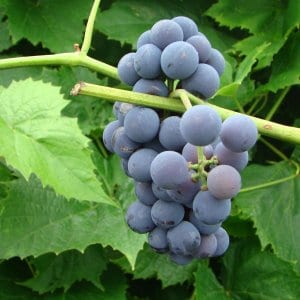Have you always dreamed of growing grapes but thought there were few options out there then think again. Thanks to years of research on grape growing, The University of Minnesota and others have developed many species that can take temperatures as low as -40F!
Here are some varieties to consider as well as growing tips for beautiful foliage and optimum results.
Varieties
Marquette
The Marquette is a red grape that was developed by the University Of Minnesota primarily for those wishing to grow quality grapes for making red wine in colder and more challenging climates. It’s prestigious lineage includes the famous and often sought after Pinot Noir.
Marquette is highly resistant to all the most common grape diseases and is moderately vigorous, so you get a strong, healthy vine in less time than some other varieties. The high sugar content and pleasant flavor make this grape a great choice for the landscapes of Minnesota. If wine is not your thing, Marquette is an excellent grape for jam, jelly, and juice.
The Frontenacs
Ah, the Frontenac, this loose clustered and easy to grow variety is extremely disease and cold resistant. The good news is that you can get Frontenac or Frontenac Gris, which is the white grape version of Frontenac. Another white version is Frontenac Blanc, which is known to be slightly more disease resistant than Frontenac Gris.
For a stunning look, you could plant both the white and red versions of Frontenac on an arbor or patio. The luxurious leaves and contrast between the two grapes will be sure to catch everyone’s eye.
John Viola
With it’s eye-popping color this is a popular grape with kids and adults alike. This is one of the most colorful grapes you can find. If you are looking for something different when it comes to landscaping, then this might be the grape for you. It has only been around since the 1970s but has a definite place in cold climate grape growing.
King Of The North
With a name like King Of The North, how could it not be an ideal grape for Minnesota? This medium red grape is as cold hardy as you can get and grows very vigorously. The trailing foliage is perfect for your arbor, trellis, or other decorative structure. This variety produces large berries that are normally used for jam, jelly, and juice.
Sabrevois
This variety is grown a lot in parts of Ottawa, Canada and for many good reasons. Cold hardy to -35 F, this dark red variety is usually used to make a quality rose wine. A high level of disease resistance means this grape is easy to maintain and always looks good. The dark green leaves and large berry size of the grape clusters are impressive. The growth rate is high.
Planting Considerations
Drainage
Grapes like good drainage so although it may seem like it would be beautiful to plant a grape in a certain place, it is also important to remember that a long life and reasonable growth rate are important too. Grapes should never be planted where there is a tendency for water to puddle.
There is no doubt that watering grape vines during dry conditions will help with growth. Too much water can cause shallow roots and lead to root rot. A bit of extra watering, in the beginning, is desirable for the establishment the first year and as needed after that.
Creating Drainage
Sometimes an area can have drainage added if you want an arbor or grape trellis in a particular spot. ALD can help assess drainage concerns and implement the needed changes for landscape needs.
Sunlight
Shaded areas mean grapes will naturally grow slower. If you want a high growth rate then planting where they get the sun first in the morning will help. Grapes can take some shade if you have to plant them in a certain area.
Long Term Commitment
Grape vines are very deep rooted. Once established it can be very difficult to remove them by the roots. The older the vine, the harder it is going to be. Grape vines do require some pruning and if you start having insect issues you may need to have a spray applied at least a few times per year, especially if fruit production is a top goal and not just foliage.
Scale Of Planting
Just a few grape vines can provide a lot of foliage for a trellis. Many people only have 1-2 vines for arbors and patios. This can be a substantial amount of fruit for the small landowner. For those that want more than this, the standard distance between vines for best results is 6-8 feet.
Trellis
ALD can design and construct the grape arbor or trellis you have always wanted. Even those with smaller yards and spaces often have time for a tasteful arbor or trellis over a walkway or small patio area. Wood, metal, or stone could be used. Stone columns could support larger beams above a patio upon which grapes grow.
Temperature
USDA zone maps place Minnesota in either Zone 3 or 4. This means that in some areas you may be able to grow a few more varieties than in other parts of Minnesota. If your USDA zone is four you may still want to consider planting the varieties that are tolerant to the temperatures of Zone 3. This ensures that you don’t have to worry about winter vine death and will have the best possible results.
Fertility
Grapes don’t have to have the best soil in the world to grow. In fact, many people recommend only fertilizing the first year or two of growth and lightly at that. Grapes are tough as long as you are planting those that can take the temperatures and disease pressures of where you live. Soil pH can usually be easily adjusted if it is off a bit.





